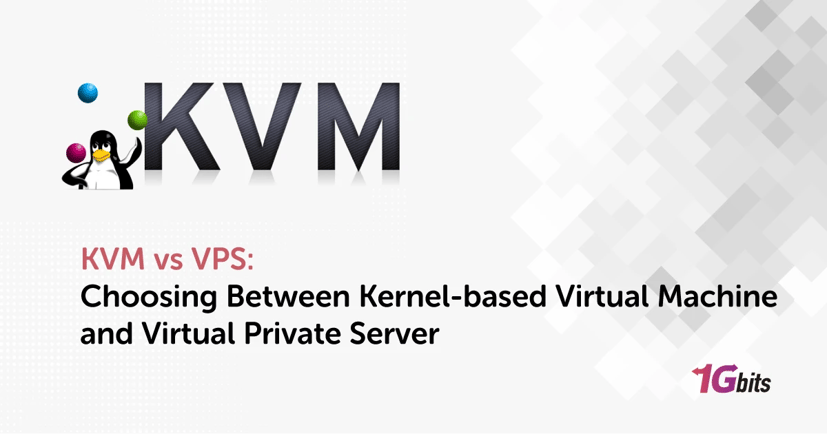When diving into the world of virtualization, one often encounters a multitude of terms and options, each with its unique benefits and use cases. Among these, KVM (Kernel-based Virtual Machine) and VPS (Virtual Private Server) stand out as two prominent choices. Understanding the differences and similarities between KVM vs VPS is crucial for making informed decisions about your virtualization needs. This article will provide an in-depth comparison of KVM vs VPS, helping you determine which is best suited for your requirements.
We'll explore the KVM VPS meaning, delving into what makes it a powerful and flexible option for many users. Questions like "Is KVM better than VirtualBox?" and "How does KVM compare to vSphere?" what is a kvm vps? will be addressed to give a comprehensive view. Additionally, we'll look at KVM vs VM, KVM vs bhyve, and the advantages of using a Linux KVM VPS.
For those on a budget, we'll discuss the availability of KVM VPS cheap options. Furthermore, the comparison will extend to kvm vs vsphere, KVM vs ESXi, providing a thorough understanding of where each stands. To uncover all these aspects and more, read the rest of the article for a detailed comparison of KVM vs VPS and make an informed decision about your virtualization strategy.
To deepen your understanding of VPS solutions, check out our comprehensive guide on What is VPS Hosting. This article provides essential insights into VPS hosting, helping you see how it compares with other virtualization options like KVM.
What Is a KVM?
A Kernel-based Virtual Machine (KVM) is an open-source virtualization technology integrated into the Linux kernel. KVM allows a physical server to run multiple isolated virtual environments called virtual machines (VMs). Each VM runs its own operating system (OS), and appears to the user as a standalone server. KVM utilizes hardware virtualization extensions, such as Intel VT-x and AMD-V, to provide efficient, fully virtualized environments.
To understand the nuances of KVM, it’s essential to compare it with Virtual Private Servers (VPS). A VPS is a virtualized server that emulates a physical server. Traditionally, VPS is implemented using a hypervisor like KVM, Xen, or other virtualization technologies. However, KVM vs VPS isn't a straightforward comparison since KVM is a virtualization technology, while VPS is a type of service provided using various virtualization technologies, including KVM.
KVM is a hypervisor that converts the Linux kernel into a type-1 (bare-metal) hypervisor. This means that it runs directly on the host's hardware, providing high performance and resource isolation. In the context of KVM vs VPS, KVM offers the capability to create multiple VMs with full access to the underlying hardware, leading to efficient use of resources and improved performance.
On the other hand, VPS services are typically provided by hosting companies and can be built on top of different virtualization technologies, such as KVM, OpenVZ, or VMware. When comparing KVM vs VPS, it’s important to note that a VPS can be a KVM VPS if it uses KVM as the underlying hypervisor. This distinction is crucial because a KVM-based VPS provides dedicated resources and better isolation compared to other VPS implementations like OpenVZ, which uses container-based virtualization.
A key aspect of the KVM vs VPS discussion is resource allocation. KVM allows for precise allocation of resources like CPU, memory, and storage, ensuring that each VM gets dedicated resources without interference from other VMs. This is especially beneficial for performance-sensitive applications. In contrast, some VPS implementations may oversell resources, leading to potential performance degradation when multiple VPS instances compete for the same resources.
Another consideration in the KVM vs VPS debate is flexibility and control. KVM offers greater flexibility because it supports a wide range of guest operating systems, including various Linux distributions, Windows, and others. This makes KVM a versatile choice for different use cases. Conversely, the flexibility of a VPS depends on the underlying virtualization technology. A KVM VPS, for instance, provides the same level of flexibility and control as a standalone KVM setup, whereas container-based VPS solutions might offer limited OS options and configurations.
Security is another important factor when evaluating KVM vs VPS. KVM provides robust isolation between VMs, reducing the risk of security breaches. Each VM operates independently, and issues within one VM do not affect others. In contrast, some VPS technologies, particularly those based on container virtualization, share the host’s kernel, which could pose security risks if vulnerabilities in the shared kernel are exploited.
In summary, when considering KVM vs VPS, it’s essential to understand that KVM is a powerful hypervisor technology that enables the creation of VMs with dedicated resources and robust isolation. A VPS, depending on its underlying technology, can vary in performance, flexibility, and security. A KVM VPS leverages the strengths of KVM to offer high performance, flexibility, and secure isolation, making it a preferable choice for users needing reliable and efficient virtualized environments.
For a deeper understanding of KVM technology and how it enhances virtualization, explore our guide on What is the KVM Virtualizor.
What Is a VPS?
A Virtual Private Server (VPS) is a virtualized server that emulates a physical server within a larger, physical host machine. Each VPS operates independently, with its own operating system, resources, and configuration, giving users the benefits of a dedicated server at a fraction of the cost. VPS hosting is a popular choice for websites, applications, and services that require more control and resources than shared hosting but don't need the full capabilities of a dedicated server.
In the realm of virtualization, the comparison of KVM vs VPS is common. KVM (Kernel-based Virtual Machine) is a type of hypervisor technology used to create and manage virtual machines. KVM transforms the Linux kernel into a bare-metal hypervisor, allowing multiple isolated VMs to run on a single physical server.
A VPS, on the other hand, is a service that can be implemented using various virtualization technologies, including KVM. Therefore, when we discuss KVM vs VPS, we are often comparing the underlying technologies and their implications on VPS performance and capabilities.
One of the primary advantages of a VPS is resource allocation. Unlike shared hosting, where multiple websites share the same resources, a VPS allocates a specific amount of CPU, RAM, and storage to each virtual server.
This ensures more consistent performance and stability. In the context of KVM vs VPS, a VPS utilizing KVM technology can offer even more precise and dedicated resource allocation. This is because KVM allows for hardware-level virtualization, which can deliver near-native performance and better isolation compared to some other VPS technologies, such as OpenVZ, which uses container-based virtualization.
Security is another critical factor in the KVM vs VPS discussion. KVM-based VPS instances benefit from strong isolation, as each VM runs its own kernel and operates independently of others. This isolation reduces the risk of security vulnerabilities spreading between VMs. On the other hand, container-based VPS solutions might share the same kernel, potentially increasing the risk if a vulnerability is found in the shared kernel. Therefore, a VPS using KVM can provide superior security and stability for applications requiring high levels of isolation.
Flexibility and control are also significant benefits of using a VPS. Users can install and configure their preferred operating systems, applications, and services without the limitations often found in shared hosting environments.
When comparing KVM vs VPS, it's clear that KVM-based VPS solutions offer extensive flexibility. KVM supports a wide range of operating systems, including various Linux distributions and Windows, making it a versatile choice for diverse user needs.
Another consideration in the KVM vs VPS debate is performance. KVM, with its hardware-assisted virtualization, often provides better performance for resource-intensive applications compared to container-based virtualization technologies.
This is because KVM can directly access the host machine’s hardware, allowing for more efficient processing and resource usage. As a result, VPS solutions using KVM are particularly well-suited for high-demand applications, such as databases, large websites, and development environments.
In summary, when examining KVM vs VPS, it's essential to recognize that KVM is a robust virtualization technology that enhances the capabilities of a VPS. A VPS provides users with dedicated resources, improved performance, and greater control compared to shared hosting.
When powered by KVM, a VPS can offer enhanced security, better resource allocation, and more flexibility, making it an ideal choice for users needing reliable and efficient virtualized environments. Therefore, a KVM-based VPS is often the preferred option for those seeking a balance of cost, performance, and control in their hosting solutions.
For more information on securing your own virtual server, explore our comprehensive guide on how to buy a VPS, where we outline essential factors to consider for an optimal purchase.
Why Use a KVM?
A Kernel-based Virtual Machine (KVM) is a virtualization technology integrated into the Linux kernel. It allows a single physical server to run multiple isolated virtual machines (VMs), each with its own operating system and resources. KVM leverages hardware virtualization extensions such as Intel VT-x and AMD-V to provide efficient, fully virtualized environments. This capability makes KVM a powerful tool for server consolidation, resource optimization, and enhancing IT infrastructure.
Performance and Efficiency
One of the primary reasons to use KVM is its performance and efficiency. KVM transforms the Linux kernel into a type-1 (bare-metal) hypervisor, which means it runs directly on the host's hardware. This direct access to hardware resources results in near-native performance for VMs. In the context of KVM vs VPS, this distinction is crucial. While VPS can be implemented using various virtualization technologies, a KVM-based VPS stands out for its superior performance and efficient resource utilization. By directly managing the hardware, KVM ensures minimal overhead, allowing VMs to run efficiently even under heavy workloads.
For a deeper understanding of how KVM compares to other virtualization technologies, including LXC, check out our detailed analysis in 'KVM vs LXC.
Resource Isolation and Allocation
KVM provides excellent resource isolation and allocation. Each VM under KVM has dedicated CPU, memory, and storage resources, which prevents resource contention and ensures consistent performance. When comparing KVM vs VPS, it's important to note that not all VPS technologies offer the same level of isolation. For example, container-based VPS solutions like OpenVZ share the host's kernel and can lead to performance degradation when multiple containers compete for the same resources. KVM, on the other hand, guarantees that each VM operates independently, providing robust isolation and predictable performance.
Security and Stability
Security is a paramount concern in virtualization, and KVM excels in this area. Each VM in a KVM environment runs its own kernel, which enhances security by isolating VMs from one another. In the KVM vs VPS debate, this level of isolation is a significant advantage over container-based VPS solutions, where all containers share the same kernel. A vulnerability in the shared kernel could potentially compromise all containers. KVM’s architecture reduces this risk, making it a more secure choice for sensitive applications and data.
Flexibility and Control
KVM offers unmatched flexibility and control over the virtualized environment. It supports a wide range of operating systems, including various Linux distributions, Windows, and others. This versatility makes KVM suitable for diverse use cases, from development and testing to production environments. When comparing KVM vs VPS, a KVM-based VPS allows users to customize their VMs extensively, installing any operating system and configuring it to their specific needs. This level of control is often not available in other VPS implementations, which may restrict OS choices and configurations. If you are looking for a reliable solution to meet your needs, consider buying Windows VPS server, which provides the benefits of KVM's flexibility along with the robust performance of Windows.
Cost-Effectiveness
Using KVM can be highly cost-effective. By consolidating multiple virtual machines on a single physical server, organizations can optimize their hardware investments and reduce operational costs. In the KVM vs VPS context, a KVM-based VPS provides a cost-effective solution without compromising on performance, security, or flexibility. Organizations can achieve significant savings by leveraging KVM's efficient resource management and reduced hardware requirements.
In summary, the decision to use KVM is driven by its performance, efficiency, security, flexibility, and cost-effectiveness. When evaluating KVM vs VPS, it's clear that KVM-based VPS solutions offer distinct advantages. They provide near-native performance, robust resource isolation, enhanced security, and extensive flexibility.
These attributes make KVM an ideal choice for organizations looking to optimize their IT infrastructure, improve resource utilization, and ensure secure and reliable operations. A KVM-based VPS combines the benefits of KVM technology with the convenience of virtual private servers, making it a superior option for many virtualization needs.
For a deeper understanding of how KVM compares to Hyper-V and the advantages each offers, be sure to check out our detailed comparison in the post on KVM vs Hyper-V.
Why Use a VPS?
A Virtual Private Server (VPS) is a virtualized server that mimics a dedicated server within a larger physical server. Each VPS operates independently, with its own operating system, resources, and configuration, providing users with a dedicated environment at a lower cost compared to a physical dedicated server. VPS hosting is a popular choice for websites, applications, and services that require more control and resources than shared hosting but do not need the full capabilities of a dedicated server.
For those considering the advantages of VPS hosting, exploring the top 10 benefits of using VPS for your business can provide valuable insights into how this solution can enhance your online presence and operational efficiency.
Performance and Reliability
One of the primary reasons to use a VPS is its superior performance and reliability compared to shared hosting. In a shared hosting environment, resources such as CPU, memory, and storage are shared among multiple users, which can lead to performance issues during high traffic periods. In contrast, a VPS allocates specific resources to each virtual server, ensuring consistent performance. When considering KVM vs VPS, it’s important to note that a VPS using KVM technology can offer even greater performance due to hardware-level virtualization, which provides near-native performance and efficient resource utilization.
To fully leverage the benefits of a VPS, understanding how to log in and manage your server is essential; check out our guide on how to log in to VPS for detailed instructions.
Resource Allocation and Scalability
VPS offers dedicated resources, which means that CPU, RAM, and storage are allocated specifically to each VPS instance. This dedicated allocation ensures that other users’ activities do not affect your server’s performance. In the KVM vs VPS debate, a KVM-based VPS stands out because KVM allows for precise resource allocation and scalability. Users can easily scale their resources up or down based on their needs, making a VPS an ideal solution for growing businesses or applications with variable workloads.
Security and Isolation
Security is a significant advantage of using a VPS. Each VPS is isolated from others on the same physical server, providing a higher level of security than shared hosting. In the context of KVM vs VPS, a KVM-based VPS offers even stronger isolation. KVM ensures that each virtual machine runs its own kernel, preventing security vulnerabilities in one VM from affecting others. This robust isolation makes a KVM-based VPS a secure choice for applications handling sensitive data or requiring stringent security measures.
Flexibility and Customization
A VPS offers a high degree of flexibility and customization. Users have full root access, allowing them to install and configure any software or application they need. When comparing KVM vs VPS, it’s clear that a KVM-based VPS provides the same level of flexibility, supporting a wide range of operating systems and configurations. This allows users to tailor their server environment to meet specific requirements, whether they are running a web server, database, or custom application.
Cost-Effectiveness
Using a VPS is cost-effective, providing a balance between the affordability of shared hosting and the power of a dedicated server. VPS hosting typically comes at a lower cost than dedicated servers, making it an attractive option for small to medium-sized businesses. In the KVM vs VPS context, a KVM-based VPS offers enhanced performance, security, and flexibility at a competitive price, delivering excellent value for the investment.
In summary, the decision to use a VPS is driven by its performance, reliability, security, flexibility, and cost-effectiveness. When evaluating KVM vs VPS, it's evident that a VPS, particularly one utilizing KVM technology, offers distinct advantages. A KVM-based VPS combines the benefits of dedicated resource allocation, strong isolation, and extensive customization with the affordability of virtual private servers. This makes it an ideal choice for businesses and developers seeking a robust, secure, and scalable hosting solution. By choosing a KVM-based VPS, users can ensure they receive the performance and control needed to support their applications and growth.
For those specifically looking for Windows-based solutions, exploring the options for the best Windows VPS can further enhance your hosting experience by providing tailored features that cater to Windows environments.
KVM vs VPS
In the world of virtualization, understanding the differences and advantages of various technologies is crucial for making informed decisions. Two prominent concepts are KVM (Kernel-based Virtual Machine) and VPS (Virtual Private Server). KVM is a virtualization technology integrated into the Linux kernel, allowing a physical server to run multiple isolated virtual machines (VMs). VPS, on the other hand, refers to a virtualized server environment provided to users, typically by a hosting company, which emulates a dedicated server within a larger physical server. When comparing KVM vs VPS, it’s important to recognize that KVM is a type of hypervisor technology often used to implement VPS services.
Performance and Resource Management
When evaluating KVM vs VPS, performance is a critical factor. KVM provides superior performance due to its hardware-level virtualization, which minimizes overhead and ensures efficient resource allocation. This means that a VPS using KVM can handle high-demand applications with minimal latency and maximum efficiency. Conversely, some VPS solutions, especially those based on container virtualization like OpenVZ, may suffer from resource contention and performance degradation when multiple instances compete for shared resources.
For a deeper understanding of the differences in virtualization technologies, check out our comparison of KVM and Xen, where we explore their unique advantages and use cases.
Security and Isolation
Security is another crucial aspect of the KVM vs VPS debate. KVM excels in providing strong isolation between VMs, as each VM runs its own kernel and operates independently. This reduces the risk of security breaches affecting multiple VMs. In contrast, container-based VPS solutions share the host’s kernel, which can pose security risks if a vulnerability in the shared kernel is exploited. Thus, a KVM-based VPS offers enhanced security and isolation, making it a preferable choice for applications requiring robust security measures.
Flexibility and Customization
Flexibility is a significant advantage in the KVM vs VPS comparison. KVM supports a wide range of operating systems and allows extensive customization of the virtual environment. Users can install and configure any operating system and applications they need, making KVM a versatile choice for various use cases. In contrast, some VPS implementations may have limitations on the types of operating systems and configurations they support, reducing their flexibility.
Cost-Effectiveness
Cost is an important consideration when comparing KVM vs VPS. Both KVM and VPS offer cost-effective solutions for virtualization, but a KVM-based VPS often provides better value for money due to its superior performance, security, and flexibility. Organizations can achieve significant cost savings by consolidating multiple virtual machines on a single physical server using KVM, optimizing hardware utilization, and reducing operational costs.
In summary, the KVM vs VPS comparison highlights the strengths of each virtualization approach. KVM, as a robust hypervisor technology, provides near-native performance, strong security, and extensive flexibility. A VPS, depending on its underlying technology, offers dedicated resources and greater control compared to shared hosting.
A KVM-based VPS combines the benefits of both, delivering high performance, robust security, and versatile customization options. For businesses and developers seeking reliable, efficient, and cost-effective virtualized environments, a KVM-based VPS is often the superior choice.
For a deeper understanding of how KVM compares to OpenVZ, explore our detailed analysis in the article on KVM vs. OpenVZ.
Conclusion
In the KVM vs VPS comparison, it is evident that each has its unique strengths and applications. KVM excels in performance, security, and flexibility, making it a robust choice for high-demand and sensitive applications. On the other hand, VPS offers the advantage of dedicated resources and greater control compared to shared hosting. However, the true advantage shines in a KVM-based VPS, which combines the benefits of KVM’s hardware-level virtualization with the practicalities of VPS. This synergy provides superior performance, enhanced security, and extensive customization options. Ultimately, in the KVM vs VPS debate, a KVM-based VPS emerges as the optimal solution for businesses and developers seeking reliable, efficient, and cost-effective virtualized environments, offering the best of both worlds.
To further enhance the security and reliability of your VPS, consider implementing best practices outlined in our guide on securing your VPS. Taking proactive measures ensures your virtual environment remains safe and optimized for performance.















